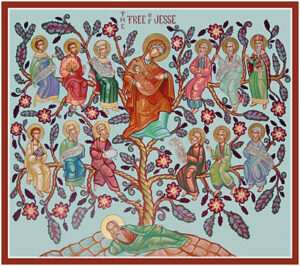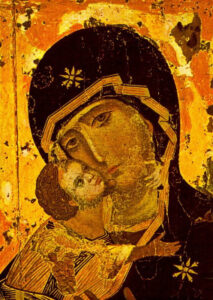The Sunday before Christmas is known to the Orthodox as the Sunday of the Holy Genealogy. On this day the Church commemorates the ancestors of Christ from Adam to Joseph the Betrothed. Christ’s full humanity meant not just that he possessed a human nature but that he had blood relatives, and that he came from a long family line. One of the shortcomings of modern culture is the tendency to leave the past behind and focus on the now. This has resulted in people feeling rootless and incomplete.
In Orthodoxy we remember our ancestors because they are part of us. To remember our family and our family roots is to affirm our humanity; likewise, to overlook our family connections is to diminish our humanity. To remember is an act of love and faithfulness. We all came from somewhere. Our family heritage is a source of blessing and sometimes a source of pain. As Christians we have both a biological and a spiritual family lineage. Salvation in Christ extends to both family lines. St. Paul writes in Ephesians 3:14-15:
For this reason I bow my knees to the Father of our Lord Jesus Christ, from whom the whole family in heaven and on earth is named….
Here Paul is looking to the future when all of humanity and creation become one family under the fatherhood of God.
The Matins Service, which precedes the Divine Liturgy, has been likened to Orthodoxy’s equivalent of Sunday School for adults. It is liturgical in structure being made up of fixed prayers and hymns. It also contains didactic teachings. The passages below are taken from the Synaxarion of the Matins Service.
On this day, the Sunday before the Nativity of Christ, we have been enjoined by our holy and God-bearing Fathers to make commemoration of all them that from the beginning of time have been well-pleasing unto God, from Adam even unto Joseph the Betrothed of the Most Holy Theotokos, according to genealogy, as Luke the Evangelist hath recounted historically; and likewise for the Prophets and Prophetesses, especially of Daniel the Prophet and the three holy youths.
It is also known as the Sunday of the Holy Genealogy. We remember the aforementioned names, those in the Old Testament who were related to Christ by blood, and those who spoke of His Birth as a man. In the Divine Liturgy, we shall read of Jesus Christ’s lineage from the Gospel of Saint Matthew. In this way, the Church shows us that Christ truly became a man, taking on human nature. He was not a ghost, an apparition, a myth, a distant imagined god, or the abstract god of philosophers; such a god does not have a family tree. Our God is the God of Abraham, Isaac and Jacob. He has flesh and blood, human ancestors—many of whom sinned greatly, but like David, also repented greatly. Yet, all of these righteous ones in every age had been well-pleasing to God because they loved Him. By taking on human nature, the Son of God became like us in all ways, in flesh and blood, in mind and soul, and in heart and will. He differed from us in only one way: He could not sin. Since we know that Christ’s human nature remained sinless, He is also fully divine, and He shows us the way in which we can avoid sin, and so improve and transform our human nature.
By their holy intercessions, O God, have mercy upon us and save us. Amen.
The first paragraph teaches us that it is part of the Orthodox Tradition to remember our ancestors in the faith. The Sunday before Christmas is an appropriate time to remember the ancestors of Christ. It provides us an opportunity to reflect on the way God works mysteriously and sometimes obscurely in our family history. It also reminds to have faith that God is working redemptively in human history. Sin might be present but God’s grace even more so (Romans 5:15).
The second paragraph affirms Jesus’ blood relatives. The second paragraph asserts that Jesus was a real historical person and not some mythical figure. This means that Christian theology is ultimately grounded in the empirical events of the birth of Jesus Christ, his life and ministry, his crucifixion under Pilate and his third day resurrection. The truth claims of Orthodox Christianity rests ultimately on a historical chain of testimony pointing to the historical events of Christ’s life and teaching.
There is a hunger among many Protestants and Evangelicals for a historically grounded Christianity. This is evidenced by a recent upsurge of interest in the early Church Fathers and ancient liturgical practices. It is also evidenced by many Evangelicals becoming enamored with the writings of the original Reformers like John Calvin. But it will take more than reading ancient theological writings and incorporating long forgotten practices to fill this hunger. The Sunday of the Holy Genealogy is a reminder that the Orthodox Church has a historical lineage that reaches back to the original Apostles. Those who are hungering for the historic Christian faith would do well to consider the Orthodox Church.
Robert Arakaki




Recent Comments